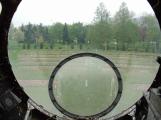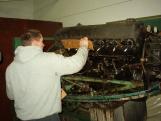1
The crew at the dedication for the Logo - Windsor, Ont.20th Century
Windsor, Ontario
 Credits:
Credits:Stan Jones
2
The Canadian Historical Aircraft Association was launched in 1992 by a group of Windsor area aviation and history enthusiasts. In 1993, the first general meeting was held, a Mission Statement adopted, and projects worthy of the group's attention identified. Among these were the restoration of the Lancaster Bomber in Jackson Park, the collection and preservation of local aviation records, and the acquisition of WWII trainer aircraft.The Association is housed at the 401 Hangar in Windsor, on the grounds of the former 1939 Elementary Flight Training School #7. Since 1992, it has acquired Mosquito parts from the North West Territories, and purchased a fuselage from New Zealand, as well as two De Havilland Chipmunks and a Boeing Stearman. These three planes make up a group named the Yellow Birds who perform fly-overs at a variety of functions. It recently obtained a T 33 Silver Star and an Evans VP-1 Volksplane for static display.
The East wall inside the Hangar has the original "Bad Penny" Logo on it as well as the names of the crew members. Many functions are held at the Hangar each year.
3
Lancaster FM 212 view from bomb aimer's nose blisterPost WWII
Windsor, Ontario
 Credits:
Credits:Michael Kohuch
4
The Lancaster Bomber was on a plinth at Jackson Park surrounded by a magnificent rose garden. Plaques honoring veterans were also in this location. This was owned by the City of Windsor, but the care of it was entrusted to a group of individuals who wanted to maintain it. This group eventually became the Lancaster C.R.E.W.(Citizens Restoring an Exceptional Warbird).Each Spring many of these members would climb ladders and do some general cleaning, in particular the removal of wasp and bird nests. The plane began showing signs of wear and it was taken down and placed inside a work station at the park. In its place two fiberglass replicas of a Spitfire and a Hurricane were put up. The work area was limited in space and the work on the plane was not able to be done effectively at that place.

